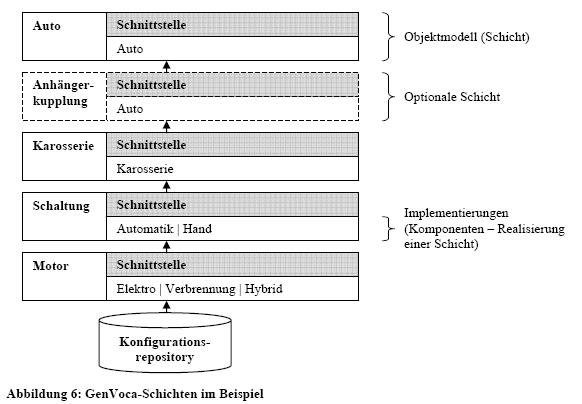3.2.3.1 GenVoca
The GenVoca method developed 1988 from the two projects genesis and Avoca of Don Batory and O' Malley, which concerned themselves with the use of DATA container LIBRARies. Within the range of the Generativen programming GenVoca is used as formal description of layer architectures and grammar for the development of a generator for the change of components with same interface, and focused likewise re-use and computer families. A generator has the goal of providing software systems automatically. Don Batory in addition: "Given A GenVoca model, incoming goods CAN create A family OF applications by composing feature" 97.
It closes the gap between the system description and the implementation of the system, and must specific requirements at speed, storage allocation, resources administration etc. fulfill. GenVoca solves the problem of the production of a generator by means of a compositional beginning as layer-oriented model. Each abstract data type or a characteristic is represented in its own layer. Each layer contains thereby a number of classes, which continue to refine the subordinated layer with classes and methods. The classes clarify parameterizable components, which can be represented from component view in a tree structure. The configuration knowledge from the domain analysis becomes thereby layer for layer of far carried98.
A manufacturer generator must examine a requirement specification within the range of the computer family development, completes, optimizes and the implementation to generate. Finished program products and likewise half products99 can do this.
An exemplary cutout clarifies this: 100

The components of a layer are summarized in a category (realm). A category can be understood in such a way as a library about exchangeable components, which is outward represented over a uniform interface.
Over parameters to the upper layer will then hand over, which component of the subordinated layer is to be used with the realization. The structure of the layers and their categories is transferred into a context-free GenVoca grammar, which with the help of the component categories and designing principles from the configuration knowledge means, which combinations at mandatory or choice-requiring parts is possible. Each expression along the grammar is a realizable Familienmitglied101.

The structure deposited in the grammar is converted by means of a suitable language as Templates. Such a developed generator can go through now all layers step by step and develop members of the described computer family.
| Evaluation of the GenVoca-Modells102 |
| Advantages | Disadvantages |
Table 16: Evaluation of the GenVoca model
- 97: See [Bato 2005] P. 1 FF
- 98: See [Czar 1998] P. 119 FF and 134 FF
- 99: See [Tamm 2004] P. 2
- 100: See [Brüg 2005] chapter 2 FF and [ice 2002-2] foil 54 FF
- 101: See [Brüg 2005] chapter 2 FF and [ice 2002-2] foil 1 FF
- 102: [Arno 2005] foil 51 FF